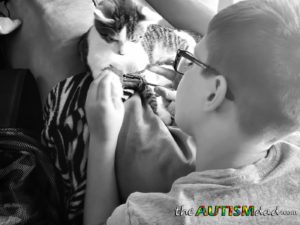 Image source – https://www.pexels.com/photo/animal-dog-pet-labrador-8700/
Image source – https://www.pexels.com/photo/animal-dog-pet-labrador-8700/
They say that a pet is man’s best friend, but they are so much more than this. For a child that has autism, a pet can change their life for the better. There have been numerous reports and studies that have investigated the benefits of bringing a pet into the family home if you have a child with autism. So, in this blog post, the advantages of this are going to be explored in further detail so that you can find out what a family cat, dog or any other animal your kid is drawn to, will bring out the best in them.
So, what are the benefits of pets for children with autism?
Socialisation
There is only one place to begin, and this is with socialization. A lot of children with autism have problems socializing with others. This is where a pet can really help them to come out of their shell. As autistic children see the world differently, social interactions can be a real challenge. This means that a lot of autistic children do not interpret emotional cues in the same manner that we do, which causes them to withdraw from a young age. One of the best ways to overcome this is with a pet. The affection of a dog, cat or any other animal, can help your child to be more confident in their ability to establish a bond. This is something they will carry with them into other areas of their life, making them more confident with people around them and helping them to talk to other children at school.
Not only this but when your child is walking their dog or out in the garden playing with their rabbit, it can encourage people to come over and greet the animal, which creates an opportunity for interaction for your child. If a child’s pet is popular – which, let’s face it, most animals are – then it makes your child feel popular too, and this can work wonders for their self-esteem.
Acceptance and support
Another major benefit of bringing a pet into the home is that it will give your child support and acceptance. Of course, as parents, you support your child, but the support of an animal is different and often very welcomed. Emotional support animals make kids feel secure. You can read more on how to get an ESA (Emotional Support Animal) online if this is the route you want to go down when getting a pet for your child.
It is also important to consider the fact that pets have special needs of their own, which can really help a child with special needs. Autistic kids can often feel alienated and alone. This is because they feel like they are the only person in the world that is different. They can’t understand why they aren’t the same as their friends or their parents. And, so when you introduce someone to the family that also has different needs, it can make a child feel accepted. Interacting with a pet that has its own unique set of needs helps the child to see that not everyone is the same, yet they are just as lovable exactly the way they are. Also for even more information about training, I recommend that you read this article – emotional support dogs – everything you need to know. It gives great in-depth information on everything you really need to know about them and their many benefits
Behavioural improvements
There have been a number of studies that have revealed that there have been behavioral improvements in children with autism after they have interacted with animals. One study showed that, after interacting with a guinea pig instead of interacting with a toy, children with autism temporarily improved their behavior. This is why a lot of schools do often bring pets into the classroom to help children.
It gives your child some responsibility
Another added benefit of bringing a pet into the family home is that it will give your child some responsibility. This is the case for any kid, not only those that have autism. Pets require feeding, cleaning, and looking after, just like humans do. By giving your child this responsibility, it can teach them some valuable life lessons and help them to become more responsible overall.
Hopefully, you now have an understanding of the benefits that are associated with bringing a pet into your family. However, it is also important to recognize that all families are different, and so you need to think about the right pet for you and your child.
What sort of pet is going to be right for you? Well, there are a number of factors to take into account. In most cases, it is better to go for a big dog rather than a small dog. You should avoid a young puppy if your child is prone to squeezing, pulling hair, pulling tails, and other minor aggressive actions. It is also a good idea to stay away from young kittens and hamsters. Hamsters are nocturnal, and if they are disturbed, they can get very grumpy, and they may even bite. Also, if your child has an unusual taste in pets and wants a reptile or a chinchilla, you’re going to need to say no. If your child touches a reptile and then puts their fingers in their mouth, it could cause them to get very ill and develop salmonella. What about chinchillas? Well, your pet could meet a very untimely death if it is squeezed because chinchillas don’t have rib cages, and so it’s best not to bring one into the home.
So, aside from young dogs and older puppies, what other animals could you consider? Older kittens are also a good choice. Older rabbits make great pets too. Guinea pigs are very gentle and have been the basis of a lot of studies on pets and kids with autism, and so they also make a great choice. Aquariums can be very relaxing for children that have autism, but you will miss out on a lot of the benefits that have been mentioned above, as they are a ‘look at only’ type of pet.
Once you have decided on the type of pet you are going to bring into the family home, it is a good idea to go over some ground rules with your children. Make sure your child knows that the pet needs his or her own space sometimes, that it is part of the family, that it needs to be taken care of every day, and that it is for keeps – they can’t change their mind and get rid of their new fluffy friend at a later date.
Hopefully, you now have a better understanding regarding the relationship between pets and children with autism. As you can see, there are many reasons why pets are a good option for any child that has autism. Not only do they help children to feel accepted and provide them with a great source of support, but they can bring them out of their shell, encourage them to be more sociable, and improve their behavior overall. Nevertheless, you do need to consider your choice of an animal with care, and you need to make sure you put some ground rules in place too.
This is a collaborative post and does not necessarily reflect the views and opinions of this blog or its author.



